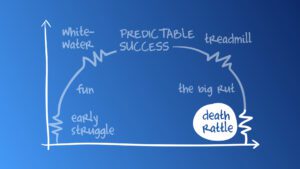Unfortunately for every business, there will come a day when it is no more. 90% of the Fortune 500 firms from 50 years ago are no longer on the list. Back then, the average time a firm spent on the list was 75 years. Today it is estimated to be only 15 years.
While many of these great businesses do still exist today, most are a shadow of their former selves, and the rest simply aren’t here anymore. They’ve gone bankrupt, been bought out, were sold off for asset value, or just closed up shop.
This is the unfortunate reality of the final stage of the Predictable Success lifecycle, Death Rattle.
There is a greater question here: why is it so hard to stay successful?
Why is it so hard to stay successful?
When a company dies, the magazine, news, and blog articles quickly identify a lack of cash, low sales, outdated technologies, or external market shifts. While it’s true that one or more of these factors marked the end of the business, I’d argue that it actually died long ago, and it did so because of the decisions made within the organization rather than at the hand of some external force.
Yes, there are external forces at play, wars, recessions, global pandemics, and acts of God can end an otherwise perfectly healthy business, but this isn’t the case the vast majority of the time.
If you will remember back to the article, I wrote on Treadmill, the leaders in the organization make the decisions that mark the beginning of the end. These decisions can predate the final demise by years or decades or even centuries. However, I truly believe the organization’s loss of visionary risk-taking is why these organizations die.
External changes and problems happen to every organization, and organizations in Predictable Success, and even into Treadmill, retain the capacity to respond. They will make the tough calls cutting, stopping, even cannibalizing sales in their core business in order to continue to create the new growth that will enable the organization to thrive.
- GE did this under Jack Welch when they sold off every business that could not reach the number 1 or 2 spot in their market.
- Intel did this when Tom Watson threw everything the company had at electronic computers rendering their core mechanical computing machines business obsolete.
- Kimberly-Clark did it when they sold their paper mills under the bold leadership of Darwin Smith, and chose to focus on their consumer goods operations.
There are countless other stories of both victory and defeat. The one moral of all of these stories is this: the safest way to lead a company into long-term success is to take risks, execute those risks, systematize and stabilize the ship, and then do it again.
[bctt tweet=”The one moral of all of these stories is this: the safest way to lead a company into long-term success is to take risks, execute those risks, systematize and stabilize the ship, and then do it again.” username=”8figurefocus”]
The one moral of all of these stories is this: the safest way to lead a company into long-term success is to take risks, execute those risks, systematize and stabilize the ship, and then do it again.
If your company is not currently in Predictable Success, I believe the best is yet to come. Hopefully, this series has given you a clear roadmap for you to find your way to or even back to Predictable Success.
If your organization is in Predictable Success, I’d encourage you to stay and fight with the same tenacity and diligence that you fought to arrive.
If you are in Death Rattle, I doubt you have any question about it, but if somehow you aren’t quite sure, I’d like to encourage you to take the free Lifecycle assessment at https://bit.ly/Lifecycle-Quiz to find out!
[yotuwp type=”playlist” id=”PLNTSkWehajGN7UENgMdoqe9FhZ94K_xjT” ]


 Reinventing Your Big Rut Organization Post COVID-19
Reinventing Your Big Rut Organization Post COVID-19